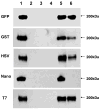The utility of affinity-tags for detection of a streptococcal protein from a variety of streptococcal species
- PMID: 18201786
- PMCID: PMC2435255
- DOI: 10.1016/j.mimet.2007.12.002
The utility of affinity-tags for detection of a streptococcal protein from a variety of streptococcal species
Abstract
There is no systematic examination of affinity tag utility in Gram-positive bacteria, which limits the investigation of protein function in this important group of bacteria as specific antibodies for many of native proteins are generally not available. In this study, we utilized an E. coli-streptococcal shuttle vector pVT1666 and constructed two sets of expression plasmids pVPT-CTag and pVPT-NTag, with each set containing five affinity tags (GST, GFP, HSV, T7 and Nano) that can be fused to either the C- or N-terminus of a target protein. A putative glycosyltransferase (Gtf2) essential for Fap1 glycosylation was used to demonstrate the utility of the cassettes in detection of Gtf2 fusion proteins, and the biological relevance of the proteins in our working strain Streptococcus parasanguinis. GFP and T7 tags were readily expressed in S. parasanguinis as either an N- or C-terminal fusion to Gtf2. Only the C- terminal fusion of GST and HSV were able to be identified in S. parasanguinis. The Nano tag was not detected in either E. coli or S. parasanguinis. Genetic complementation experiments indicated that all the tagged Gtf2 fusion proteins could restore the Gtf2 function in the null mutant except for the Nano-tagged Gtf2 at its N-terminal fusion. Using a T7-tagged Gtf2 fusion construct, we demonstrated that the fusion cassette is also useful in detection of the fusion tag expression in other streptococci including S. mutans, S. pneumoniae and S. sanguinis. Therefore, the expression cassettes we constructed will be a useful tool not only to investigate protein-protein interactions in Fap1 biogenesis in S. parasanguinis, but also to study protein functions in other gram-positive bacteria in which pVT1666 replicates.
Figures




Similar articles
-
Interaction between two putative glycosyltransferases is required for glycosylation of a serine-rich streptococcal adhesin.J Bacteriol. 2008 Feb;190(4):1256-66. doi: 10.1128/JB.01078-07. Epub 2007 Dec 14. J Bacteriol. 2008. PMID: 18083807 Free PMC article.
-
A molecular chaperone mediates a two-protein enzyme complex and glycosylation of serine-rich streptococcal adhesins.J Biol Chem. 2011 Oct 7;286(40):34923-31. doi: 10.1074/jbc.M111.239350. Epub 2011 Aug 23. J Biol Chem. 2011. PMID: 21862581 Free PMC article.
-
A novel glucosyltransferase is required for glycosylation of a serine-rich adhesin and biofilm formation by Streptococcus parasanguinis.J Biol Chem. 2010 Apr 16;285(16):12140-8. doi: 10.1074/jbc.M109.066928. Epub 2010 Feb 17. J Biol Chem. 2010. PMID: 20164186 Free PMC article.
-
Engineering and Dissecting the Glycosylation Pathway of a Streptococcal Serine-rich Repeat Adhesin.J Biol Chem. 2016 Dec 30;291(53):27354-27363. doi: 10.1074/jbc.M116.752998. J Biol Chem. 2016. PMID: 28039332 Free PMC article.
-
A conserved domain of previously unknown function in Gap1 mediates protein-protein interaction and is required for biogenesis of a serine-rich streptococcal adhesin.Mol Microbiol. 2008 Dec;70(5):1094-104. doi: 10.1111/j.1365-2958.2008.06456.x. Epub 2008 Sep 30. Mol Microbiol. 2008. PMID: 18826412 Free PMC article.
Cited by
-
New Helical Binding Domain Mediates a Glycosyltransferase Activity of a Bifunctional Protein.J Biol Chem. 2016 Oct 14;291(42):22106-22117. doi: 10.1074/jbc.M116.731695. Epub 2016 Aug 17. J Biol Chem. 2016. PMID: 27539847 Free PMC article.
-
Cyclic di-AMP mediates biofilm formation.Mol Microbiol. 2016 Mar;99(5):945-59. doi: 10.1111/mmi.13277. Epub 2015 Dec 15. Mol Microbiol. 2016. PMID: 26564551 Free PMC article.
-
Streptococcus mutans copper chaperone, CopZ, is critical for biofilm formation and competitiveness.Mol Oral Microbiol. 2016 Dec;31(6):515-525. doi: 10.1111/omi.12150. Epub 2016 Feb 4. Mol Oral Microbiol. 2016. PMID: 27753272 Free PMC article.
-
Gap2 promotes the formation of a stable protein complex required for mature Fap1 biogenesis.J Bacteriol. 2013 May;195(10):2166-76. doi: 10.1128/JB.02255-12. Epub 2013 Mar 8. J Bacteriol. 2013. PMID: 23475979 Free PMC article.
-
Antigen I/II mediates interactions between Streptococcus mutans and Candida albicans.Mol Oral Microbiol. 2018 Aug;33(4):283-291. doi: 10.1111/omi.12223. Epub 2018 Apr 26. Mol Oral Microbiol. 2018. PMID: 29570954 Free PMC article.
References
-
- Ajdiæ D, McShan WM, McLaughlin RE, Saviæ G, Chang J, Carson MB, Primeaux C, Tian R, Kenton S, Jia H, Lin S, Qian Y, Li S, Zhu H, Najar F, Lai H, White J, Roe BA, Ferretti JJ. Genome sequence of Streptococcus mutans UA159, a cariogenic dental pathogen. Proc Natl Acad Sci U S A. 2002;99:14434–9. - PMC - PubMed
-
- Arnau J, Lauritzen C, Petersen GE, Pedersen J. Current strategies for the use of affinity tags and tag removal for the purification of recombinant proteins. Protein Expr Purif. 2006;48:1–13. - PubMed
-
- Biedendieck R, Yang Y, Deckwer WD, Malten M, Jahn D. Plasmid system for the intracellular production and purification of affinity-tagged proteins in Bacillus megaterium. Biotechnol Bioeng. 2007;96:525–37. - PubMed
-
- Bricker AL, Camilli A. Transformation of a type 4 encapsulated strain of Streptococcus pneumoniae. FEMS Microbiol Lett. 1999;172:131–5. - PubMed
-
- Carlsson J, Grahnén H, Jonsson G, Wikner S. Establishment of Streptococcus sanguis in the mouths of infants. Arch Oral Biol. 1970;15:1143–8. - PubMed
Publication types
MeSH terms
Substances
Grants and funding
LinkOut - more resources
Full Text Sources
Molecular Biology Databases
Research Materials

